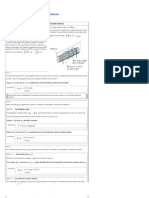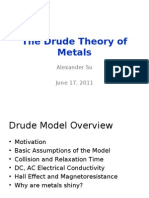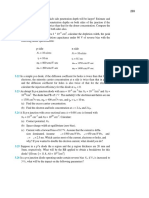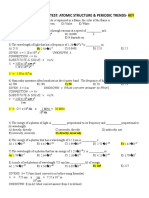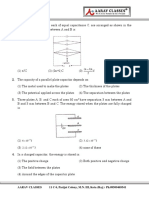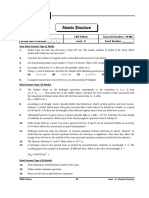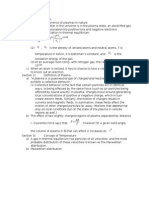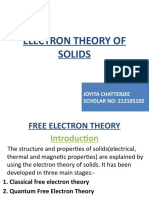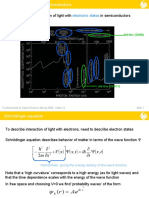0 ratings0% found this document useful (0 votes)
222 viewsHW 3
This document contains an electrical engineering homework assignment with 4 problems:
1) Analyzing a non-uniformly doped semiconductor sample by sketching band diagrams, electric fields, and carrier distributions.
2) Deriving relationships for generation and recombination of carriers under low-level injection conditions.
3) Solving the continuity equation to determine excess carrier distribution in an illuminated semiconductor bar.
4) Calculating carrier concentrations and quasi-Fermi levels for a doped silicon wafer under different light irradiation conditions.
Uploaded by
Nandan ShahCopyright
© © All Rights Reserved
Available Formats
Download as DOC, PDF, TXT or read online on Scribd
0 ratings0% found this document useful (0 votes)
222 viewsHW 3
This document contains an electrical engineering homework assignment with 4 problems:
1) Analyzing a non-uniformly doped semiconductor sample by sketching band diagrams, electric fields, and carrier distributions.
2) Deriving relationships for generation and recombination of carriers under low-level injection conditions.
3) Solving the continuity equation to determine excess carrier distribution in an illuminated semiconductor bar.
4) Calculating carrier concentrations and quasi-Fermi levels for a doped silicon wafer under different light irradiation conditions.
Uploaded by
Nandan ShahCopyright
© © All Rights Reserved
Available Formats
Download as DOC, PDF, TXT or read online on Scribd
You are on page 1/ 2
UNIVERSITY OF CALIFORNIA
College of Engineering
Department of Electrical Engineering and Computer Sciences
EE 130 / EE 230M Prof. Liu and Dr. Xu
Spring 2013
Homework Assignment #3
Due at the beginning of class on Thursday, 2/14/13
Problem 1: Non-Uniformly Doped Semiconductor
A silicon sample maintained at 300K is characterized by the energy band-diagram below:
a) Do equilibrium conditions prevail? How do you know?
b) Sketch the electrostatic potential V(x) inside the semiconductor as a function of x.
c) Sketch the electric field E(x) inside the semiconductor as a function of x.
d) Suppose the carrier pictured in the diagram moves between x = 0 and x = L without changing its total
energy. Sketch the kinetic energy and potential energy of the carrier as a function of x.
e) Roughly sketch n and p versus x
f) On the same set of coordinates, make a rough sketch of the electron drift-current density and the
electron diffusion current density as a function of position. For each drawing, briefly explain how you
arrived at your sketch.
Problem 2: Generation and Recombination of Carriers
Assume that the energy level associated with defects within a Si sample is near midgap (i.e. ET Ei) so
that n1 p1 ni (ref. Lecture 5 Slide 24) and that n is comparable to p. Setting n = p, show that the
general-case R-G relationship
reduces to the special-case relationships
when low-level injection conditions prevail.
Problem 3: Continuity Equation
The two ends of a uniformly doped n-type Si bar of length L are simultaneously illuminated so as to
create ND excess holes at both x=0 and x=L. The wavelength and intensity of illumination are such that
no light penetrates into the interior (0<x<L) of the bar and =10-3. Also, steady state conditions prevail,
T=300 K and ND >> ni.
a) Based on qualitative reasoning, sketch the expected general form of the pn(x) solution.
b) Do low-level injection conditions prevail inside the illuminated bar? Explain.
c) Write down the differential equation (simplest form possible) you must solve to determine pn(x)
inside the bar.
d) Write down the general form of the pn(x) solution and the boundary condition(s) appropriate for this
particular problem.
e) Establish an expression for the hole current density (Jp) flowing in the illuminated bar at x=0. [Your
answer may be left in terms of the arbitrary constant(s) appearing in the general form of the pn(x)
solution].
Problem 4: Quasi-Fermi Levels
A silicon wafer maintained at T = 300K is doped with 1015 cm-3 donor atoms.
a) Find the electron and hole concentrations and the location of the Fermi level with respect to the
intrinsic Fermi level.
b) Light irradiating the wafer leads to a steady-state photogenerated density of electrons and holes equal
to 1012 cm-3. Assume that the wafer is thin when compared to the absorption depth for the light so that
the free carriers are uniformly distributed throughout its volume. Find the overall electron and hole
concentrations in the wafer and calculate the positions of the quasi-Fermi levels for the two carrier
types in an energy band diagram.
c) Repeat the calculations of (b) under the condition that the light intensity is increased so that the
photogeneration produces 1018 cm-3 electron-hole pairs.
You might also like
- Solutions:: 7.3 Electronic Polarization in Liquid XenonNo ratings yetSolutions:: 7.3 Electronic Polarization in Liquid Xenon14 pages
- Chapter 7 Practice Test AtomStrctrPeriodicTrend GOOD-KEY1No ratings yetChapter 7 Practice Test AtomStrctrPeriodicTrend GOOD-KEY15 pages
- Can Fermi Energy Be Determined by Heating And/or Cooling A Copper Wire?No ratings yetCan Fermi Energy Be Determined by Heating And/or Cooling A Copper Wire?5 pages
- 13.kinetic Theory of Gases and ThermodynamicsExercise PDF50% (2)13.kinetic Theory of Gases and ThermodynamicsExercise PDF57 pages
- Atomic and Molecular Spectroscopy Lecture 2No ratings yetAtomic and Molecular Spectroscopy Lecture 229 pages
- Magneticfieldlines 110930091904 Phpapp02 PDFNo ratings yetMagneticfieldlines 110930091904 Phpapp02 PDF28 pages
- Dissociation Energy of Iodine by Absorption SpectroscopyFINAL100% (1)Dissociation Energy of Iodine by Absorption SpectroscopyFINAL12 pages
- MODULE-2 Dielectrics - Practice Questions PDFNo ratings yetMODULE-2 Dielectrics - Practice Questions PDF2 pages
- Lecture Notes - Carrier Transport Phenomena - 2No ratings yetLecture Notes - Carrier Transport Phenomena - 218 pages
- Kasap SM Ch01 - Solution Manual For Chapter 1 Kasap SM Ch01 - Solution Manual For Chapter 1No ratings yetKasap SM Ch01 - Solution Manual For Chapter 1 Kasap SM Ch01 - Solution Manual For Chapter 172 pages
- Transport Processes in The Environment 5No ratings yetTransport Processes in The Environment 523 pages
- FC Questions On Magnetic Materials and Its ClassificationsNo ratings yetFC Questions On Magnetic Materials and Its Classifications13 pages
- Energy Bands and Charge Carriers in Semiconductors100% (1)Energy Bands and Charge Carriers in Semiconductors12 pages
- CHEG 320 - Electrode Kinetics - Extended NotesNo ratings yetCHEG 320 - Electrode Kinetics - Extended Notes13 pages
- Struktur Pita Dan Sifat Listrik Bahan (2015.10)No ratings yetStruktur Pita Dan Sifat Listrik Bahan (2015.10)38 pages
- Introduction To Plasma Physics and Controlled Fusion Notes For Journal 1100% (1)Introduction To Plasma Physics and Controlled Fusion Notes For Journal 118 pages
- Hydrogen Balmer Series and Rydberg Constant100% (2)Hydrogen Balmer Series and Rydberg Constant4 pages
- PH6251-Engineering Physics II Question Bank With Answers50% (2)PH6251-Engineering Physics II Question Bank With Answers58 pages
- Electron Beam-Specimen Interactions and Simulation Methods in MicroscopyFrom EverandElectron Beam-Specimen Interactions and Simulation Methods in MicroscopyNo ratings yet
- OSE5312 Slides Class 12 - Optical Properties of Semiconductors 1No ratings yetOSE5312 Slides Class 12 - Optical Properties of Semiconductors 122 pages
- Fabrication and Manufacturing Process of Solar Cell: Chapter 1No ratings yetFabrication and Manufacturing Process of Solar Cell: Chapter 132 pages
- Transformable Junctionless Transistor (T-JLT)No ratings yetTransformable Junctionless Transistor (T-JLT)6 pages
- 100 Top Electronic Devices and Circuits Questions and Answers PDF Electronic Devices and Circuits QuestionsNo ratings yet100 Top Electronic Devices and Circuits Questions and Answers PDF Electronic Devices and Circuits Questions15 pages
- Fundamentals of Electrical Engeneering - RizzoniNo ratings yetFundamentals of Electrical Engeneering - Rizzoni114 pages
- Crystals and Band Theory Bonding in Metals: The Electron Sea ModelNo ratings yetCrystals and Band Theory Bonding in Metals: The Electron Sea Model6 pages
- Semiconductor Physics Part II GATE Problem PDFNo ratings yetSemiconductor Physics Part II GATE Problem PDF19 pages
- In Schools: PV Lesson Plan 1 - Solar CellsNo ratings yetIn Schools: PV Lesson Plan 1 - Solar Cells5 pages
- The Characteristic Properties of PEDOT Nano-Particle Based On Reversed Micelle MethodNo ratings yetThe Characteristic Properties of PEDOT Nano-Particle Based On Reversed Micelle Method8 pages
- 2023 Catalytic Co2 Capture Via Ultrasonically Activating Dually Functionalized Carbon NanotubesNo ratings yet2023 Catalytic Co2 Capture Via Ultrasonically Activating Dually Functionalized Carbon Nanotubes10 pages
- Electron Interference Effects On The Conductance of Doped Carbon NanotubesNo ratings yetElectron Interference Effects On The Conductance of Doped Carbon Nanotubes18 pages
- Krishnasamy College of Engineering and Technology: EC8252 Electronic DevicesNo ratings yetKrishnasamy College of Engineering and Technology: EC8252 Electronic Devices21 pages
- Esc201: Introducton To Electronics: DiodesNo ratings yetEsc201: Introducton To Electronics: Diodes35 pages
- Information And Communication Technology (English) __ PDF Only ~ (E-BOOK)No ratings yetInformation And Communication Technology (English) __ PDF Only ~ (E-BOOK)83 pages

